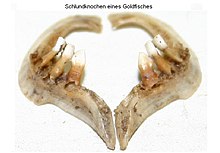Pharyngeal teeth

Pharyngeal teethareteethin thepharyngeal archof the throat ofcyprinids,suckers,and a number of otherfishspecies otherwise lacking teeth.[1]
Many popular aquarium fish such asgoldfishandloacheshave these structures. Members of the genusBotiasuch asclown loachesare known to make distinctive clicking sounds when they grind their pharyngeal teeth.Grunts(family Haemulidae) are so called because of the sound they make when they grind them.[2]Molasare said to be able to produce sound by grinding their long, claw-like pharyngeal teeth.
TheChinese high fin banded shark(Myxocyprinus asiaticus) (familyCatostomidae) has a single row of pharyngeal teeth with comb-like arrangements.[3]TheCape Fear shiner(familyCyprinidae) only has pharyngeal teeth, similar to the teeth of other omnivorous shiners.[4]Theredear sunfish(familyCentrarchidae) has thick pharyngeal teeth composed of hard, movable plates, which it uses to crush theexoskeletonsof prey. Thepharyngeal jawsof themoray eel(familyMuraenidae) possess their own set of teeth. Thedentaryof the ghost knifefish speciesSternarchogiton nattereri(familyApteronotidae) has upper and lower pharyngeal tooth plates bearing 9-11 and 7-9 teeth, respectively.
The mouth cone ( "everted pharynx" ) of a possible new species ofMeiopriapulus,a marine worm in thePriapulida,bears pharyngeal teeth.[5]
Fossils of theYunnanozoonandHaikouellapossess pharyngeal teeth.
The lower pharyngeal bones ofcichlidsalso carry specialized teeth which augment their normal mandibular teeth in the breakdown of food.
See also
[edit]- Animal tooth development
- Fish jaw:The primary oral jaws open and close the mouth, and a second set ofpharyngeal jawsare positioned at the back of the throat.
- Ichthyology terms
- Hallucigenia
References
[edit]- ^"SuckersCatostomidae",Iowa Department of Natural Resources
- ^Rocha, Luiz A.; Lindeman, Kenyon C.; Rocha, Claudia R.; Lessios, H.A. (2008)."Historical biogeography and speciation in the reef fish genusHaemulon(Teleostei: Haemulidae) "(PDF).Molecular Phylogenetics and Evolution.48(3): 918–928.doi:10.1016/j.ympev.2008.05.024.PMID18599320.Archived fromthe original(PDF)on 2013-12-17.Retrieved2013-06-03.
- ^Myxocyprinus asiaticus,Chinese sucker fish, Filamn.ifm-Geomar.de, 2006,retrieved on: August 21, 2007
- ^Groves, John."Cape Fear Shiner Conservation & Research".North Carolina Zoo. Archived fromthe originalon 2007-10-21.Retrieved2007-12-09.
- ^Park JK, Rho HS, Kristensen RM, Kim W, Giribet G (Nov 2006). "First Molecular Data on the Phylum Loricifera – An Investigation into the Phylogeny of Ecdysozoa with Emphasis on the Positions of Loricifera and Priapulida".Zoological Science.23(11): 943–54.doi:10.2108/zsj.23.943.PMID17189906.

